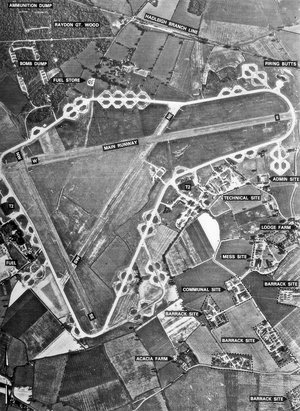RAF Raydon
| RAF Raydon USAAF Station 157  | |
|---|---|
| Located Near Raydon, Suffolk, United Kingdom | |
 RAF Raydon - September 1946 | |
| Type | Military airfield |
| Code | RA |
| Site information | |
| Owner | Air Ministry |
| Controlled by | |
| Site history | |
| Built | 1942 |
| In use | 1942- |
| Battles/wars | European Theatre of World War II Air Offensive, Europe July 1942 - May 1945 |
| Garrison information | |
| Garrison | Eighth Air Force Ninth Air Force RAF Fighter Command |
| Occupants | 357th Fighter Group 358th Fighter Group 353rd Fighter Group |
Royal Air Force Station Raydon or more simply RAF Raydon is a former Royal Air Force station located just to the northeast of the village of Raydon, about 6 miles (9.7 km) from Ipswich, England.
History
USAAF use
Raydon was primarily a fighter station for the Eighth and Ninth United States Army Air Forces (USAAF). During the Second World War it was known as USAAF Station 157.
357th Fighter Group

The first American occupants of Raydon was the 357th Fighter Group, moving in from Casper AAF, Wyoming on 30 November 1943.
Operational squadrons of the 353d were:
- 362d Fighter Squadron (G4)
- 363d Fighter Squadron (B6)
- 364th Fighter Squadron (C5)
One pilot with the 357th was a Lt. Charles ‘Chuck’ Yeager.
When the group arrived at Raydon, it was assigned as part of the Ninth Air Force. On 19 December the group received their first fighter, a single North American P-51B.
358th Fighter Group

The 358th Fighter Group moved to RAF Raydon from RAF Leiston on 31 January 1944. The 358th was initially assigned to the 66th Fighter Wing, at Sawston Hall, Cambridge, then transferred to the Ninth Air Force on 1 February 1944 in exchange for the 357th FG.
Operational squadrons of the 358th were:
- 365th Fighter Squadron (CH)
- 366th Fighter Squadron (IA)
- 367th Fighter Squadron (CP)
Group markings were red, yellow and red spinners, with a 12-inch red and yellow check band around the cowling behind the spinner. Aircraft of the 357th were P-47D "Thunderbolts".
At RAF Raydon the group's mission was to attack enemy communications and fly escort missions with the light bomb groups of the 9th AF. On 13 April 1944 the 358th was transferred to RAF High Halden.
353d Fighter Group


Replacing the 9th AF 358th FG was the 353rd Fighter Group, moving in from RAF Metfeld in April 1944. The 353d was assigned to the 66th Fighter Wing, at Sawston Hall, Cambridge.
Operational squadrons of the 353d were:
- 350th Fighter Squadron (LH)
- 351st Fighter Squadron (YJ)
- 352d Fighter Squadron (SX)
Group markings were black, yellow, black, yellow spinners, with a 48-inch black and yellow check band around the cowling to the end of the exhaust stubs. In October 1944, the group converted to the P-51 "Mustang".
The 353d flew combat missions until the end of April 1945. After the end of hostilities, the group trained and prepared for transfer to the Pacific Theater. After the end of World War II, in September, the group left Raydon and transferred back to Camp Kilmer, New Jersey where it was inactivated on 18 October 1945.[1][2]
RAF Fighter Command use
After the Americans left, Raydon was transferred back to RAF Fighter Command on 20 December 1945. The airfield remained under RAF control but was not used for any flying units. In 1952, a small part of the airfield was sold for agricultural use, and the station was closed on 8 August 1958.
During 1960/62 the Air Ministry sold the remaining airfield parts of RAF Raydon to agricultural interests, retaining most of the technical site for storage of emergency vehicles by the Home Office. They were given up and sold in the 1980s.
The local fire brigade used the airfield from 1965 for a short period to practice fire extinguishing.[clarification needed]
Current use
With the end of military control Raydon was converted into Notley Industrial Park. The buildings that remain are largely unaltered in appearance.
Raydon has also been the scene of some paranormal incidents, one being the sighting of an American MP with his dog, still patrolling the airfield.
Unfortunately the control tower and much of the concrete parts of the airfield was removed in the 1960s, being used to construct the A12 highway. Today RAF Raydon retains many of the buildings of the old technical site, including two T-2 hangars in very good condition (one used by the farmer and the other used for car storage).
However some of the taxiways and part of the main runway is still intact. The firing Butts are also still intact but are covered by a large growth of foliage.
Raydon is one of the more complete Second World War USAAF airfield (bases) in East Anglia that was not used by the United States Air Force during the Cold War.
See also
References
![]() This article incorporates public domain material from the Air Force Historical Research Agency
This article incorporates public domain material from the Air Force Historical Research Agency
Citations
- ^ Maurer 1980, p. 00.
- ^ Freeman 2001, p. 00.
Bibliography
- Freeman, R. Airfields of the Eighth - Then and Now. After the Battle. London, UK: Battle of Britain International Ltd., 2001. ISBN 0-9009-13-09-6.
- Freeman, Roger A. (1991) The Mighty Eighth: The Colour Record. Cassell & Co. ISBN 0-304-35708-1
- Maurer, M. Air Force Combat Units Of World War II. USAF Historical Division. Washington D.C., USA: Zenger Publishing Co., Inc, 1980. ISBN 0-89201-092-4.
- USAAS-USAAC-USAAF-USAF Aircraft Serial Numbers--1908 to present


